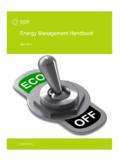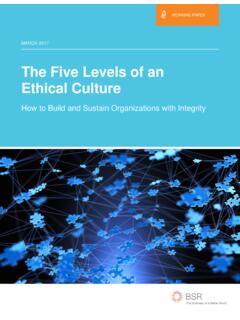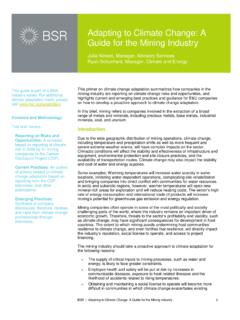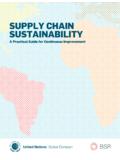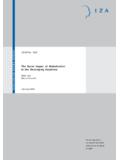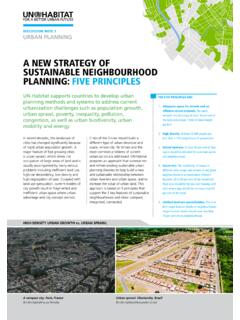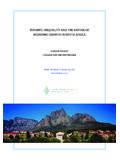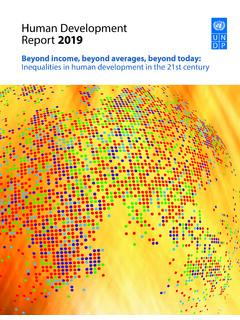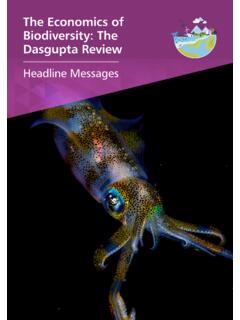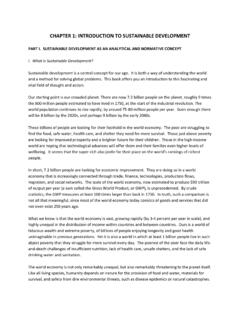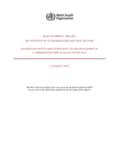Transcription of Climate Change: Implications for Agriculture
1 Key Findings from the Intergovernmental Panel on Climate Change Fifth Assessment ReportClimate Change: Implications for AgricultureP2 Climate : everyone's BusinessRising temperatures:The Intergovernmental Panel on Climate Change (IPCC) Fifth Assessment Report (AR5) concludes that Climate change is unequivocal, and that human activities, particularly emissions of carbon dioxide, are very likely to be the dominant cause. Changes are observed in all geographical regions: the atmosphere and oceans are warming, the extent and volume of snow and ice are diminishing, sea levels are rising and weather patterns are :Computer models of the Climate used by the IPCC indicate that changes will continue under a range of possible greenhouse gas emission scenarios over the 21st century. If emissions continue to rise at the current rate, impacts by the end of this century are projected to include a global average temperature degrees Celsius ( C) higher than present, and sea levels metres higher than prevent the most severe impacts of Climate change, parties to the UN Framework Convention on Climate Change (UNFCCC) agreed a target of keeping the rise in average global temperature since pre-industrial times below 2 C, and to consider lowering the target to C in the near first instalment of AR5 in 2013 (Working Group I on the physical science basis of Climate change) concluded that by 2011, we had already emitted about two-thirds of the maximum cumulative amount of carbon dioxide that we can emit if we are to have a better than two-thirds chance of meeting the 2 C of past emissions.
2 Even if emissions are stopped immediately, temperatures will remain elevated for centuries due to the effect of greenhouse gases from past human emissions already present in the atmosphere. Limiting temperature rise will require substantial and sustained reductions of greenhouse gas Physical science of Climate ChangeIMPLICATIONS FOR Agriculture P3 The Fifth Assessment Report from the Intergovernmental Panel on Climate Change is the most comprehensive and relevant analysis of our changing Climate . It provides the scientific fact base that will be used around the world to formulate Climate policies in the coming document is one of a series synthesizing the most pertinent findings of AR5 for specific economic and business sectors. It was born of the belief that the Agriculture sector could make more use of AR5, which is long and highly technical, if it were distilled into an accurate, accessible, timely, relevant and readable the information presented here is a translation of the key content relevant to this sector from AR5, this summary report adheres to the rigorous scientific basis of the original source material.
3 Grateful thanks are extended to all reviewers from both the science and business communities for their time, effort and invaluable feedback on this basis for information presented in this overview report can be found in the fully-referenced and peer-reviewed IPCC technical and scientific background reports at: about this documentPuBlisHeD:June 2014 For more inFormation:e-mail: :Edward CameronrevieWers:Laura Ediger, Tara Norton Cambridge Project Team:Nicolette BartlettStacy GilfillanDavid ReinerEliot WhittingtonProJeCt DireCtor:Tim NuthallProJeCt manaGer/eDitor:Joanna BenneDitorial Consultants:Carolyn Symon, Richard BlackProJeCt assistants: Myriam Castani , Simon McKeagneylayout DesiGn:Lucie Basset, BurnthebookinFoGraPHiC:Carl De Torres Graphic DesignP4 Climate : everyone's BusinessKey FindingsClimate-related impacts are already reducing crop yields in some parts of the world, a trend that is projected to continue as temperatures rise further.
4 Crops affected include staples such as wheat, maize and rice. Climate change is projected to increase price volatility for agricultural commodities, and reduce food can adapt to some changes, but there is a limit to what can be managed. Adaptive capacity is projected to be exceeded in regions closest to the equator if temperatures increase by 3 C or more. The agricultural industry s own interests are best served by ambitious approaches to adaptation and to cutting emissions. Greenhouse gas (GHG) emissions from Agriculture comprised about 10 12% of man-made GHG emissions in 2010. The sector is the largest contributor of non-carbon dioxide (non-CO2) GHGs such as for mitigation include reducing emissions from land use change, land management and livestock management. Carbon can be captured and stored in soil and biomass. Economy-wide emissions from energy use can be reduced, under certain conditions, by replacing fossil fuels with biofuels.
5 The potential for reducing GHG emissions from Agriculture through changes in consumption could be substantially higher than technical mitigation options. Approaches include reducing food waste, changing diets towards less GHG-intensive food ( substitution of animal products with plant-based food), and reducing overconsumption in regions where this is prevalent. This summary looks at Climate risk, resilience and GHG mitigation potential relevant for the agricultural sector and not for the broader AFOLU ( Agriculture , Forestry and Other Land Use) landscape. Implications FOR Agriculture P5 The effects of Climate change on crop and food production are already evident in several regions of the world, with negative impacts more common than positive ones. Without adaptation, Climate change is projected to reduce production for local temperature increases of 2 C or more (above late-20th-century levels) up to 2050, although individual locations may benefit.
6 After 2050, the risk of more severe yield impacts increases and depends on the level of warming. Climate change will be particularly hard on agricultural production in Africa and Asia. Global temperature increases of 4 C or more, combined with increasing food demand, would pose large risks to food security globally and gas emissions from Agriculture comprised about 10 12% of global GHG emissions in 2010. The sector is the largest contributor of non-CO2 GHGs (including methane), accounting for 56% of non-CO2 emissions in 2005. Opportunities for mitigation include so-called supply and demand side options. On the supply side, emissions from land use change, land management and livestock management can be reduced, and terrestrial carbon stocks can be increased by sequestration in soils and biomass. Emissions from energy use across the entire economy can be reduced through the substitution of fossil fuels by biomass providing certain conditions are met.
7 On the demand side, GHG emissions could be cut by reducing losses and waste of food, and by encouraging changes in diet. The agricultural industry s own interests are best served by implementing ambitious approaches to mitigation to ensure that key temperature thresholds are not crossed, while also working to enhance resilience in the face of inevitable temperature rises and associated Climate events. While adaptation to Climate impacts is possible, largely by extending techniques already in existence, there is a limit to what can be managed. Adaptive capacity is projected to be exceeded if temperature increases by 3 C or more, especially in regions close to the equator. Executive SummaryP6 Climate : everyone's Businessimpacts of Climate ChangeFood security Recent extreme climatic events, such as heat waves, droughts, floods, and wildfires, are combining with long-term trends including rising temperatures and changes in precipitation patterns, with broad and deep Implications for the agricultural sector and global food security.
8 Terrestrial ecosystems that provide a variety of services vital for agricultural production, including nutrient cycling, waste decomposition and seed dispersal, will be undermined and even lost through Climate change. After habitat loss, Climate change is the most important threat to pollinating insects on a global yields Greenhouse gas emissions over many decades are already affecting production of rice, wheat and maize. Without adaptation, local temperature increases of 2 C are expected to reduce yields further. While CO2 in most cases has a stimulating effect on plant growth, ozone reduces growth. Elevated ozone levels have very likely suppressed global production of crops, causing estimated losses of 10% for wheat and soybean. These are some aspects of a complex picture involving interactions between CO2, ozone, mean temperature rise, temperature extremes, reduced water availability and changes to the nitrogen cycle, whose overall effect is difficult to predict.
9 In addition, areas suitable for cultivation of coffee, tea and cocoa, which support millions of smallholders in over 60 countries, are likely to be significantly reduced by temperature rise and other factors. These projected impacts will occur as demand for crops is expected to increase by about 14% per decade until 2050. Risks are greatest in tropical countries Climate -related risks for Agriculture are particularly acute in developing countries. They expose vulnerabilities of farmers and pastoralists who lack resources fundamental to resilience including finance, technology and knowledge. Moreover, Climate -related risks interact with existing environmental stressors such as biodiversity loss, soil erosion, and water contamination, and with social stressors such as inequality , poverty , gender discrimination, and lack of institutional capacity. These interactions compound risks to agricultural production and food security.
10 Water security In many regions, changing levels and patterns of precipitation, melting snow and ice, and retreating glaciers are altering hydrological systems, affecting water resources and quality. Climate change is projected to reduce renewable surface water and groundwater resources significantly in most dry subtropical regions. Each degree of warming is expected to decrease renewable water resources by at least 20% for an additional 7% of the global population. Major impacts are projected on water availability and supply, food security, and agricultural incomes, including shifts in production areas of food and non-food FOR Agriculture P7 Price volatility A major factor in recent food price rises has been increased crop demand, notably driven by increased take-up of land for biofuel production. Yet weather-related fluctuations in food production are also believed to have played a role, with recent price spikes often following Climate extremes in major producing nations.
